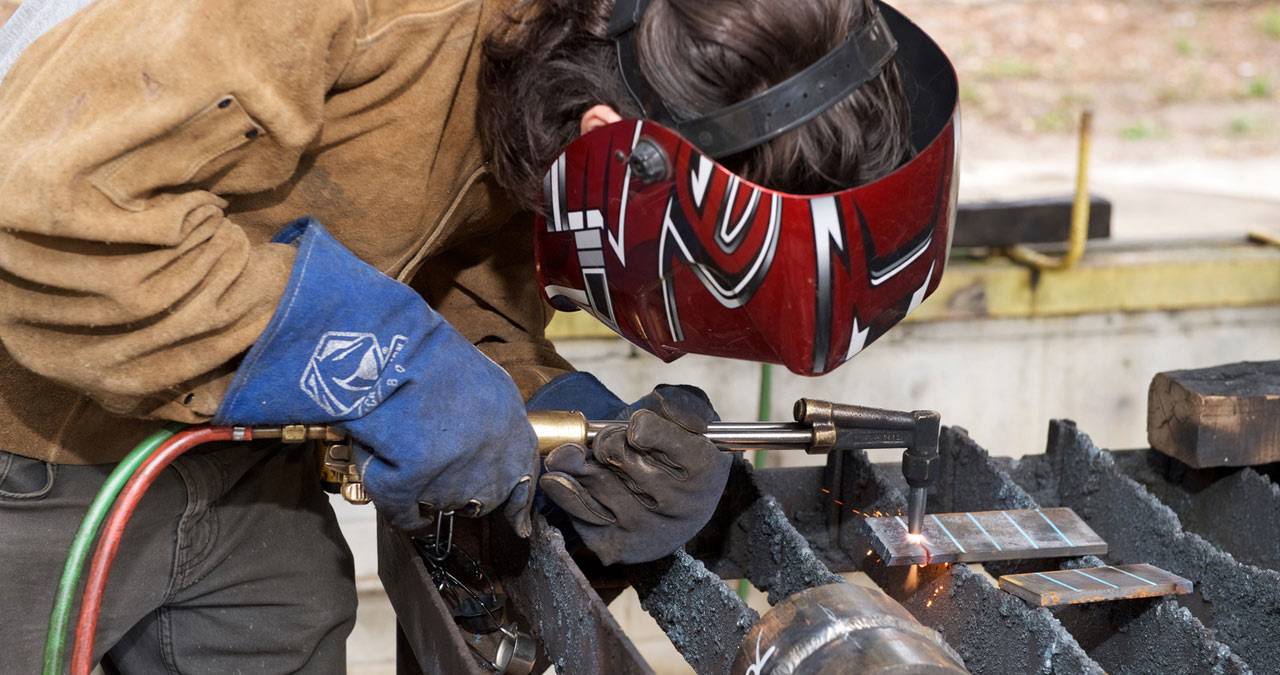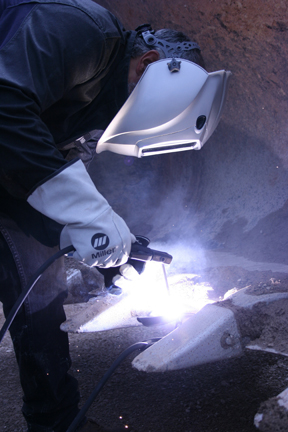Common Welding Repair Issues and Just How to Address Them Efficiently
Welding repair work frequently come across a range of problems that can threaten the honesty of the last product. Typical problems include poor penetration, porosity, and imbalance, to name a few. Each problem presents unique challenges that need particular techniques for resolution. Recognizing these concerns is essential for welders aiming to boost their outcomes and abilities. This conversation will certainly check out these usual welding fixing problems and reliable approaches to address them.
Inadequate Infiltration
Poor penetration takes place when the weld steel stops working to completely fuse with the base product, resulting in weak joints and potential architectural failings. This problem usually comes from insufficient warmth input, incorrect electrode angle, or improper welding speed. Welders might encounter insufficient penetration as a result of a miscalculation of the essential parameters for a details product thickness or kind. Furthermore, contamination on the base product's surface area can impede reliable bonding, intensifying the problem. To address poor infiltration, welders must assure proper setups on their equipment and preserve a tidy job surface area. Routine evaluation of welds is suggested to identify any type of deficiencies early, enabling prompt modifications and the avoidance of compromised architectural stability in bonded assemblies.
Porosity
Porosity is an usual problem in welded joints that materializes as tiny gas bubbles trapped within the weld steel. This issue can compromise the integrity of the weld, leading to reduced stamina and potential failing under anxiety. Montana Mobile Welding and Repair Welding. Porosity normally emerges from contamination, dampness, or improper welding methods, which allow gases to get away into the molten weld pool. To address porosity, welders need to guarantee proper surface area preparation, preserve a clean workplace, and use appropriate welding criteria. Additionally, choosing the ideal filler material and shielding gas can alleviate gas entrapment. Normal inspection and screening of welds can aid determine porosity early, assuring prompt corrective actions are taken, thus maintaining the quality and reliability of the welded framework
Imbalance
Imbalance in welding can develop from various factors, including improper setup and thermal development. Recognizing the origin is essential for efficient resolution. A number of adjustment strategies are offered to realign components and assure architectural honesty.
Causes of Misalignment
Welding imbalance often stems from a selection of underlying issues that can endanger structural stability. One primary reason is inappropriate fit-up of parts prior to welding, which can cause voids and uneven surface areas. Variations in thermal growth throughout the welding process can likewise cause distortion, particularly if the products being signed up with have different coefficients of development. In addition, poor clamping and fixturing may fail to hold components securely in area, bring about activity throughout welding. Improperly conserved devices, consisting of welding devices and devices, may present inconsistencies in the weld bead, additional adding to imbalance. Driver error, stemming from not enough training or experience, can additionally play a significant role in producing misaligned welds.

Improvement Methods Offered
Resolving misalignment efficiently calls for a combination of corrective techniques tailored to the particular issues handy. One typical technique is making use of jigs or components to hold components in the right placement during welding, guaranteeing regular alignment. Furthermore, preheating the products can aid lower distortion and enhance fit-up. For significant imbalance, mechanical adjustment methods, such as utilizing hydraulic jacks or clamps, can be used to remedy the position before welding. Post-weld warmth treatment might additionally be essential to eliminate stress and anxieties brought on by imbalance. Ultimately, mindful inspection and change throughout the arrangement stage can stop misalignment concerns from becoming considerable troubles, promoting a smoother welding procedure and enhancing total structural stability.
Distortion
Distortion is an usual obstacle in welding that can emerge from numerous variables, consisting of uneven home heating and air conditioning. Comprehending the causes of distortion is crucial for implementing effective prevention techniques. Resolving this concern not just enhances structural stability but also improves the general top quality of the weld.
Sources of Distortion
When based on the extreme warm of welding, materials often undergo modifications that can cause distortion. This phenomenon largely occurs from thermal development and contraction during the welding procedure. As the weld area warms up, the material broadens; upon air conditioning, it contracts, which can develop inner stress and anxieties. Furthermore, uneven heating throughout a workpiece can exacerbate these anxieties, causing bending or bending. The type of material likewise plays a significant function; steels with differing thermal conductivity and coefficients of development may respond in a different way, causing unpredictable distortions. Poor joint design and inadequate fixturing can add to misalignment throughout welding, raising the possibility of distortion. Understanding these causes is necessary for reliable welding fixing and avoidance strategies.
Prevention Techniques
Efficient prevention methods for distortion during welding concentrate on managing heat input and making sure correct joint layout. Maintaining a consistent warmth input helps to minimize thermal growth and tightening, which can lead to distortion. Making use of methods such webpage as preheating the work surface can likewise minimize the temperature gradient, advertising consistent home heating. Furthermore, selecting ideal joint layouts, such as T-joints or lap joints, can boost security and minimize stress concentrations. Carrying out proper fixturing to safeguard the work surfaces in position additionally aids in keeping placement throughout the welding process. Lastly, staggered welding series can distribute warmth a lot more uniformly, preventing localized distortion. By applying these strategies, welders can significantly lower the possibility of distortion and boost the total quality of their welds.
Fracturing
Breaking is a common problem run into in welding repair services, typically arising from different factors such as incorrect cooling rates, product choice, or poor joint prep work. The event of fractures can substantially endanger the honesty of the weld, leading to potential failings throughout procedure. To address this problem, welders must first analyze the source, guaranteeing that products are compatible and suitably picked for the certain application. Furthermore, regulating the cooling price throughout the welding process is necessary; quick cooling can induce anxiety and cause splitting. Appropriate joint style and prep work likewise add to decreasing the threat. Applying these techniques can boost weld high quality and longevity, inevitably reducing the likelihood of fracturing in finished weldments.

Insufficient Fusion
A considerable issue in welding fixings is insufficient fusion, which occurs when the weld metal does not adequately bond with the base product or previous weld passes - Montana Mobile Welding and Repair Belgrade. This problem can lead to weak points in the joint, possibly endangering this page the integrity of the bonded framework. Variables adding to insufficient combination include not enough warmth input, improper welding method, and contamination of the surface areas being joined. To resolve this issue successfully, welders need to ensure correct pre-weld cleansing and surface prep work, as well as readjust their welding specifications to accomplish appropriate infiltration and blend. Normal evaluation throughout the welding procedure can additionally help identify incomplete combination early, allowing for timely rehabilitative procedures to improve the total top quality of the weld
Overheating
While welding fixings can boost architectural stability, overheating offers a significant difficulty that can lead to material deterioration. Too much warm throughout welding can change the mechanical residential or commercial properties of steels, resulting in reduced strength, increased brittleness, and bending. This phenomenon is especially crucial in high-stress applications where structural reliability is critical. Recognizing overheating can entail visual examinations for discoloration or distortion, as well as keeping an eye on temperature during the welding procedure. To minimize the risks associated with overheating, welders should utilize ideal strategies, such as regulating heat input, changing traveling rate, and making use of suitable filler materials. Furthermore, executing pre- and post-weld heat therapies can help restore product homes and improve the total top quality of the repair service, guaranteeing lasting performance and safety.
Frequently Asked Inquiries
What Are the Usual Indications of a Welding Issue?

How Can I Check My Welds for High quality?
To test welds for quality, one can utilize aesthetic examinations, ultrasonic screening, and radiographic approaches. Each technique guarantees architectural integrity, determines defects, and confirms adherence to specified requirements, eventually boosting the dependability of the bonded joints.
What Safety Safety Measures Should I Take While Welding?
When welding, one should prioritize safety by wearing appropriate individual safety tools, ensuring proper ventilation, protecting combustible materials away, preserving a tidy office, and knowing surroundings to stop injuries and mishaps.
Can I Fix a Weld Without Remodeling the Entire Joint?
Repairing a weld without redesigning the whole joint is feasible, depending on the damage (Belgrade Fabrication). Methods such as grinding, including filler product, or utilizing a welding process can efficiently address certain flaws while preserving the surrounding structure
What Tools Are Necessary for Efficient Welding Repair Works?
Vital tools for effective welding repairs include a welding device, cord brush, mill, safety equipment, clamps, and filler materials. Each device plays an essential role in making certain high quality and safety and security throughout the repair service process. Porosity usually emerges from contamination, moisture, or incorrect welding methods, which permit gases to run away right into the molten weld swimming pool. Inadequately conserved tools, consisting of welding devices and devices, may present disparities in the weld bead, more adding to misalignment. When subjected to the extreme warmth of welding, products often undergo adjustments that can lead to distortion. Breaking is a common concern run into in welding repair services, typically resulting from numerous aspects such as incorrect cooling rates, material option, or poor joint prep work. A significant problem in welding repair services is insufficient blend, which takes place when the weld steel does not properly bond with the base product or previous weld passes.